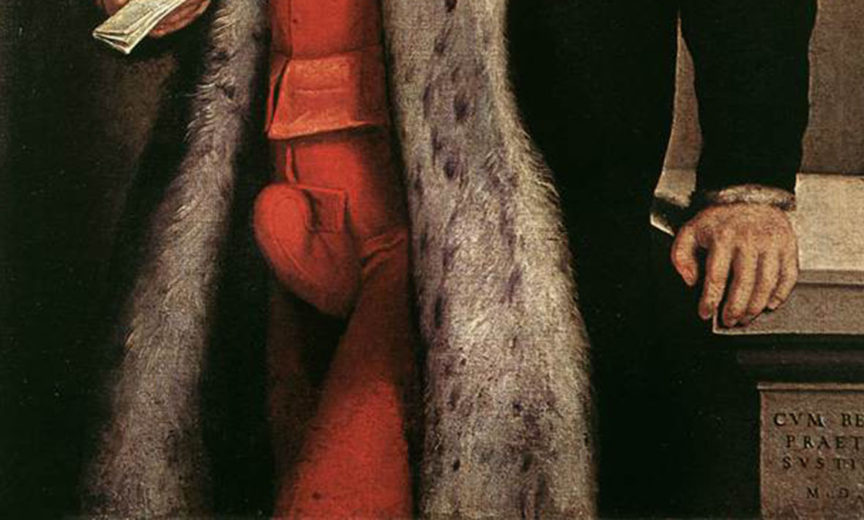I am a huge fan of the 1980’s British TV series, Blackadder. Comedian Rowan Atkinson plays Edmund Blackadder with each season taking place in a different time period. A scene in the first series involves The Black Adder’s (the 15th century Blackadder) clothing choices while getting ready to attend the announcement of the new Archbishop. He chooses the most ostentatious of clothing items, most notably his codpiece called The Black Russian since it always terrifies the clergy. The reveal of his magnificent codpiece shows a large stiff upward-curving shape.
The first Blackadder’s clothing choices are not too far from what some nobles might have done back in the day. Sexual display in male dress manifests in different ways over the millennia and many a noble was keen on some sexual display. They also like to show their power and virility. One of the more impressive displays from the past is the codpiece. These ornate protuberances started out small and practical then rose to decorative prominence then fell out of favor. How men decided to make their crotch such a fashionable focal point is an interesting evolution.
Western fashion before the 15th century consisted of tunics and hose. Hose being woven cotton, not the sheer nylon we use today. It started as two separate leg coverings that attached to a linen undergarment. The undergarment and chemise (shirt worn under the tunic) covered the crotch, which was also covered by the tunic. The tunic (called a doublet by the 15th century) kept creeping up until it barely covered the bottom, thus exposing the open space between the hose. When the tunic got short enough to be a risk when sitting or getting on a horse, they came up with the idea of sewing the hose together in the back and adding a triangular piece of fabric to the front. The front covering was attached to the hose at the bottom to create a flap then tied to the hose at the top with ribbons or cord. The new style of hose now tied to the doublet. As the doublet got even shorter the triangular flap, now more exposed, got bigger and more decorative. Dubbed the codpiece, it began to bulge and grow until it was almost as big as Edmund’s Black Russian as it became a symbol of virility, sexual prowess, or just to show off
The word codpiece comes from the Old English/Germanic word for bag, pouch or husk and the Middle English word for scrotum. The codpiece reached its peak in the mid-1500s, around the 1540s. At the beginning of the 16th century, hose became divided into upper stocks and lower stocks. They were attached to each other, but the upper stocks were made to look like a separate garment. The upper stocks evolved into breeches while the codpiece became more padded and pouch-like, so it protruded between the hose. It also may have emerged as a handy dandy pocket to store items like jewels, letters, or even, as legend has it, the occasional orange.
While the codpiece growth coincides with the spread of syphilis, it may not have been used or developed because of it. According to Anthropologist Grace Q. Vicary, the codpiece was padded out so that it didn’t press against a painfully syphilitic penis or provided space for an ulcered member wrapped in bandages. The codpiece also kept the unguents from staining the garment. This does not seem to be the case as surviving codpieces were not shaped in a way to accommodate these theories. It wouldn’t be the first time venereal disease inspires fashion as this happens more often than you think.
The codpiece was mostly the fashion accessory of the rich, the ranked, and the royal. Many Henry VIII portraits show him with a fashionable protuberance. He may have been enamored with a full stuffed codpiece because of certain insecurities. Henry was unable to produce a healthy male heir despite a parade of wives. His fascination with large codpieces was a way to let people know he did not lack in the bait and tackle. The rise of the codpiece is also seen in military dress, and some surmise may have started first in armor before clothing. Metal codpieces were a popular piece of military garb, so Henry had one as part of his ceremonial armor.
The padded codpiece is found in art from Germany, Italy, Austria, France and Spain. As the codpiece increased in size, it’s resemblance to the male member in the rest of Europe increased, especially in Italy. Paintings such as Portrait of a Halberdier by Jacomo Pontmoro, Pietro Maria Rossi – Count of San Secondo by Parmigianino dated 1535-39, Guidobaldo II della Rovere by Agnolo Bronzino dated 1530-32, and Portrait of Antonio Navagero by Giovanni Battista Moroni dated 1565 show that Italy was quite fond of the upwardly mobile, highly phallic, codpiece. You can find German woodcuts and paintings with the slashed look that was fashionable at the time, as were puffed out codpieces. Portrait of a Young Man by George Pencz, a German artist, dated 1544 has quite an impressive codpiece that seems to defy gravity.
As we enter into the Elizabethan era, from the mid to late 1500s, we see the codpiece start of whither. Well, not exactly whither but get overshadowed by other pieces of clothing. Emphasis goes away from the codpiece as the peascod belly doublet rises. The peascod belly, or goose belly, is a doublet padded in a way that resembles the chest of a bird. There is even peascod shaped armor. The puffed and padded doublet extended downward with most of the padding at or below the waist. Trunk hose now separate from the hose covering the leg, billowed out so that the fullness obscured the codpiece. Between the full belly and the full breeches, the codpiece faded into obscurity by the end of the 16th century.
Emphasis on genitalia in some way persisted until we get to the staid Victorian era. Around the 1920’s, fashion brought attention back to the body. The codpiece was resurrected in the 20th century, as seen in A Clockwork Orange, Kiss, and Cameo. We can still see it as a symbol of sexual voraciousness and the well endowed in the entertainment industry as bands from a variety of genres like heavy metal, alternative, and R&B sport modern codpieces. The prevalence for codpieces in Renaissance armor is seen on Star Wars characters and superheroes. It hasn’t made its way back into everyday clothing, but every once in a while it shows up on the runways. As a culture, we’re still obsessed with size and virility, except nowadays it’s more about pleasure than progeny.


